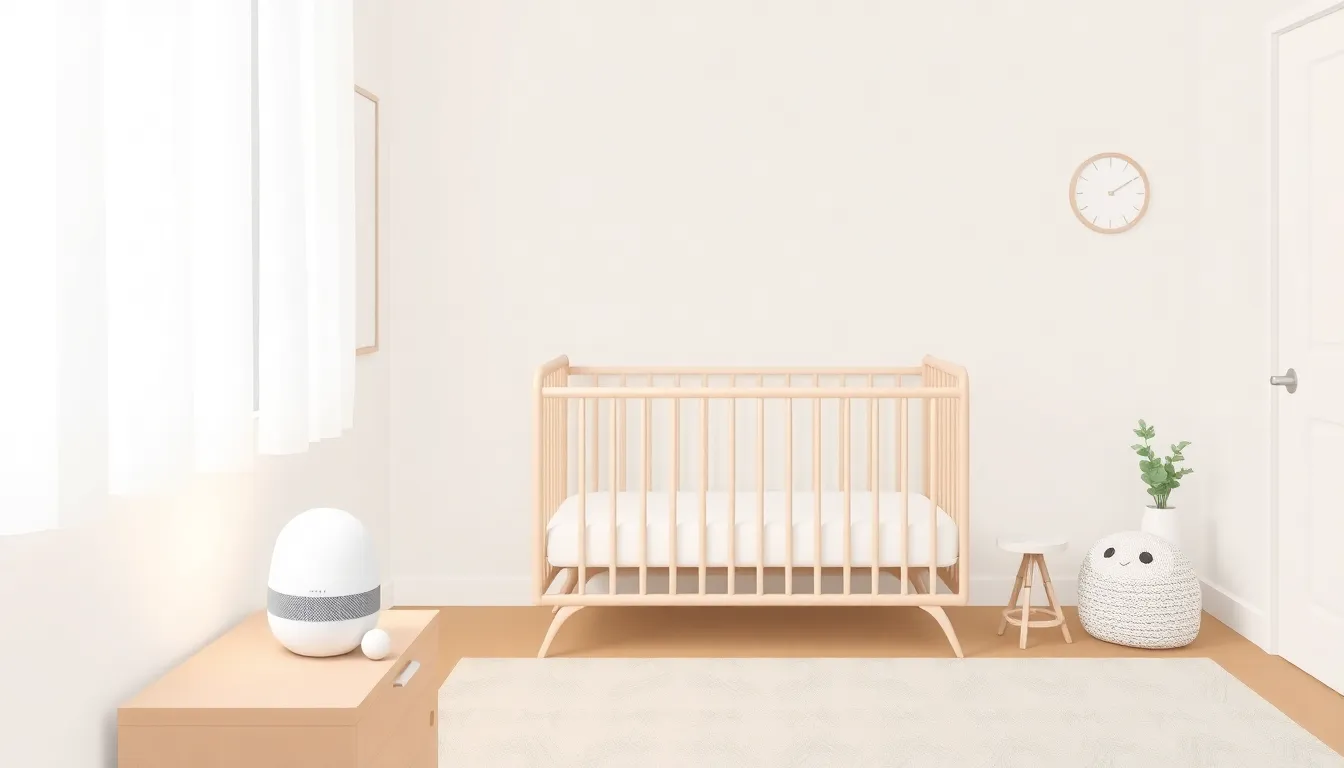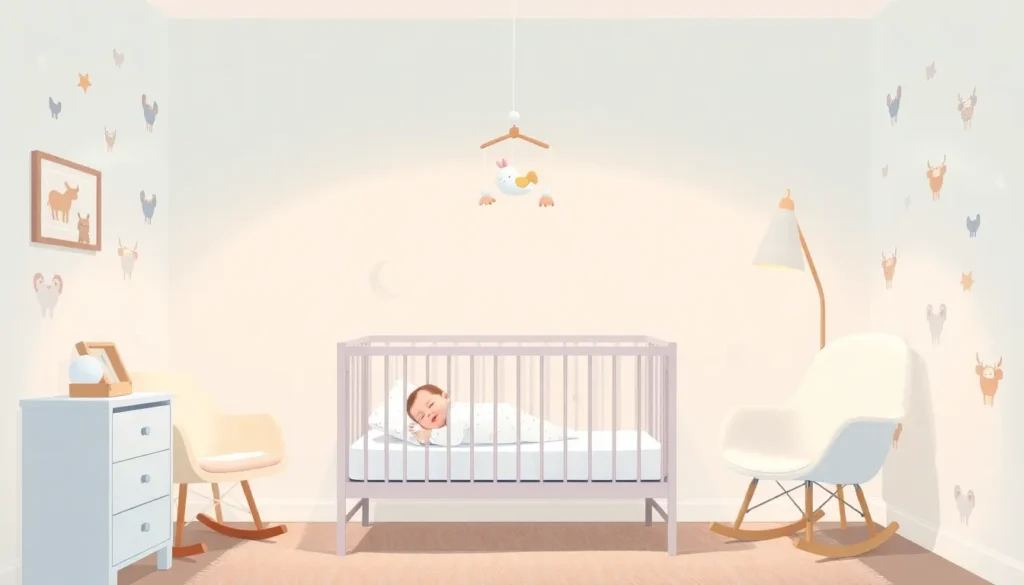Table of Contents
ToggleWhen it comes to infant sleep patterns, parents often feel like they’re navigating a mysterious labyrinth. One moment, their little bundle of joy is peacefully snoozing, and the next, they’re wide awake, ready to party at 3 AM. Understanding these sleep patterns can be the key to unlocking a more restful night for both baby and parents.
Understanding Infant Sleep Patterns
Infant sleep patterns exhibit unique characteristics that require parents’ attention. Recognizing these patterns enhances sleep quality for both the infant and the caregiver.
Stages of Infant Sleep
Infants experience two primary sleep stages: active and quiet sleep. Active sleep includes rapid eye movement (REM) and constitutes about half of their total sleep time. Quiet sleep features deep, restorative sleep during which growth occurs. Transitioning between these stages takes place multiple times each night. Parents observe periods of restlessness, which indicate movement between these stages. Understanding this cycle helps caregivers anticipate sleep needs effectively.
Importance of Sleep for Infants
Sleep plays a crucial role in an infant’s development. During sleep, vital brain development processes occur. It supports physical growth, immune function, and emotional regulation. A newborn needs approximately 14 to 17 hours of sleep each day. Quality sleep contributes significantly to cognitive functioning and learning capabilities. Infants without adequate sleep may exhibit fussiness and difficulty in mood regulation. Therefore, creating a consistent sleep environment is essential for promoting healthy sleep patterns.
Factors Affecting Infant Sleep Patterns

Infant sleep patterns can be influenced by various elements. Understanding these factors can help caregivers create an optimal sleep environment.
Environmental Influences
Light levels play a significant role in regulating sleep. Exposure to bright light during the day encourages alertness, while dim lighting promotes relaxation at night. Noise levels also impact sleep quality. White noise machines can mask sudden sounds, helping infants stay asleep. Temperature is another critical aspect. Maintaining a cool and comfortable room temperature fosters restful sleep. The sleep environment’s safety is paramount. A crib or bassinet free of any loose bedding or toys ensures a safe sleeping area. Overall, these environmental factors contribute to an infant’s ability to sleep soundly.
Biological Factors
Age significantly influences sleep patterns. Newborns require 14 to 17 hours of sleep daily, with their sleep cycles maturing as they grow. Developmental milestones can disrupt sleep. As infants reach new milestones, such as rolling over or crawling, sleep may become more fragmented. Feeding schedules also affect sleep. Infants often wake for nourishment, especially during the early months. Lastly, individual temperament can play a role. Some infants may adapt easily to sleep routines, while others may require more time to settle into consistent sleep patterns. Recognizing these biological factors helps caregivers understand and support their infant’s sleep needs.
Common Infant Sleep Issues
Infants often face various sleep challenges that can disrupt their sleep patterns and create difficulties for parents. Understanding these issues can facilitate better sleep for both infants and caregivers.
Sleep Regressions
Sleep regressions, occurring around 4 months, 8 to 10 months, and 18 months, represent periods when infants experience significant disruptions in their sleep patterns. During these times, previously established sleep habits may falter as babies deal with developmental changes. These regressions can last from a few days to several weeks. As babies grow and their brains develop rapidly, they may struggle with adjusting to new sleep cycles. Parents frequently encounter increased night awakenings, shorter naps, and difficulty calming their babies back to sleep. Recognizing that these regressions are temporary phases helps caregivers manage expectations and provide comforting routines during this challenging time.
Colic and Its Impact on Sleep
Colic affects many infants, often leading to excessive crying and restlessness, which can greatly disrupt sleep. Typically manifesting around 2 weeks of age and peaking around 6 weeks, colic symptoms can last until the baby is about 3 months old. Infants experiencing colic may exhibit signs of irritability, particularly in the late afternoon or evening. This discomfort can prevent them from settling into a calm sleep state. Parents dealing with colic often find that soothing techniques like swaddling, gentle rocking, and white noise can provide relief, promoting better sleep for both the infant and themselves. Understanding colic’s impact prepares parents to implement strategies that support their baby’s sleep needs effectively.
Tips for Managing Infant Sleep Patterns
Managing infant sleep patterns requires consistency and attention to detail. By establishing a routine, caregivers can help infants settle into healthy sleep habits.
Establishing a Sleep Routine
Routine plays a vital role in promoting healthy sleep in infants. Incorporate calming activities like bathing or reading to signal bedtime. Consistency reinforces the relationship between activities and sleep, allowing the infant to learn when it’s time to wind down. Ideally, aim for the same bedtime each night to foster predictability. Establishing a pre-sleep ritual may include dimming lights or singing lullabies, creating a tranquil atmosphere. Pay attention to the infant’s individual cues, adjusting the routine as they grow. Frequent observation and adjustment help maintain a supportive sleep pattern.
Creating a Comfortable Sleep Environment
Comfortable sleep environments significantly impact infant sleep quality. Ensure the sleep space is dark, quiet, and cool, with optimal temperatures around 68 to 72 degrees Fahrenheit. Use blackout curtains to block out unwanted light during sleep. White noise machines can mask abrupt sounds, promoting a peaceful setting. Keep the crib free from toys and loose bedding to maintain safety and minimize distractions. Choosing a firm mattress ensures support while preventing suffocation risks. By cultivating a secure and cozy environment, caregivers can enhance the chances of uninterrupted sleep and overall infant well-being.
Understanding infant sleep patterns is essential for both babies and their caregivers. By recognizing the stages of sleep and the factors that influence them, parents can create a nurturing environment that promotes restful nights. Establishing a consistent bedtime routine and being mindful of environmental conditions can significantly improve sleep quality.
While challenges like sleep regressions and colic can disrupt patterns, knowing these are temporary can help parents navigate through them. With patience and the right strategies, caregivers can support their infants’ sleep needs and foster healthy sleep habits that benefit everyone involved.







